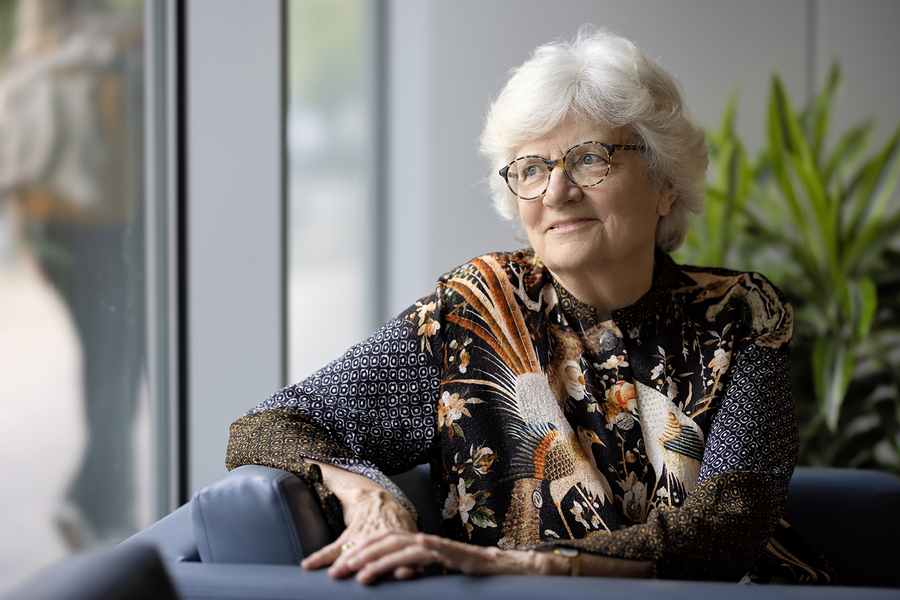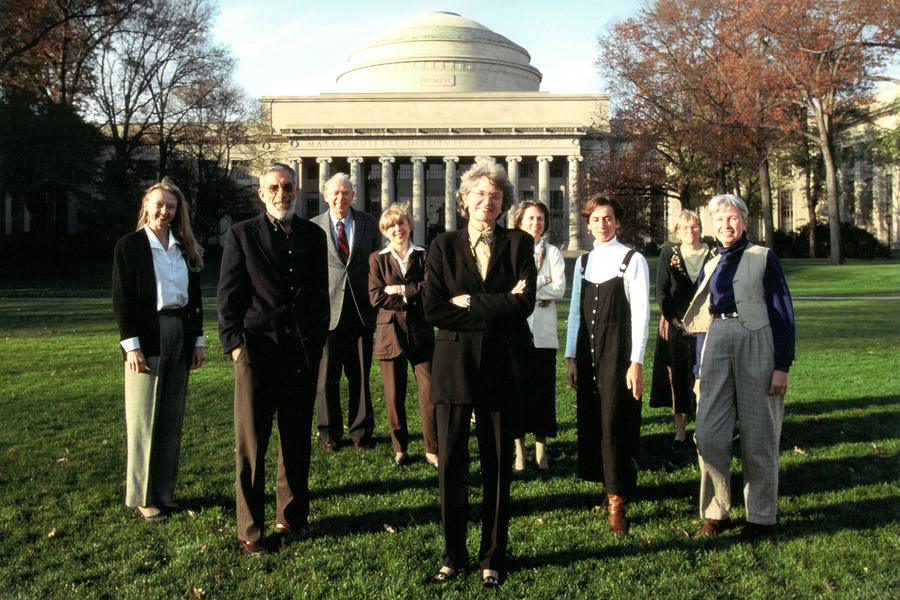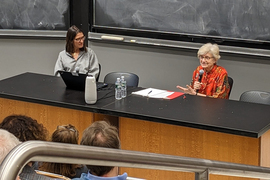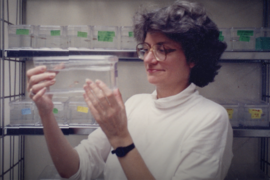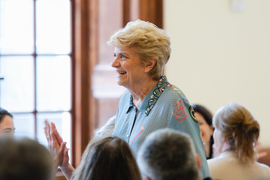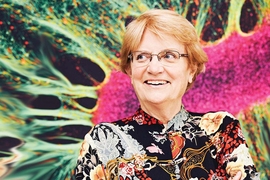The National Academy of Sciences has awarded MIT biologist Nancy Hopkins, the Amgen Professor of Biology Emerita, with the 2024 Public Welfare Medal in recognition of “her courageous leadership over three decades to create and ensure equal opportunity for women in science.”
The award recognizes Hopkins’s role in catalyzing and leading MIT’s “A Study on the Status of Women Faculty in Science,” made public in 1999. The landmark report, the result of the efforts of numerous members of the MIT faculty and administration, revealed inequities in the treatment and resources available to women versus men on the faculty at the Institute, helped drive significant changes to MIT policies and practices, and sparked a national conversation about the unequal treatment of women in science, engineering, and beyond.
Since the medal was established in 1914 to honor extraordinary use of science for the public good, it has been awarded to several MIT-affiliated scientists, including Karl Compton, James R. Killian Jr., and Jerome B. Wiesner, as well as Vannevar Bush, Isidor I. Rabi, and Victor Weiskopf.
“The Public Welfare Medal has been awarded to MIT faculty who have helped define our Institute and scientists who have shaped modern science on the national stage,” says Susan Hockfield, MIT president emerita. “It is more than fitting for Nancy to join their ranks, and — importantly — celebrates her critical role in increasing the participation of women in science and engineering as a significant national achievement.”
When Hopkins joined the faculty of the MIT Center for Cancer Research (CCR) in 1973, she did not set out to become an advocate for equality for women in science. For the first 15 years, she distinguished herself in pioneering studies linking genes of RNA tumor viruses to their roles in causing some forms of cancer. But in 1989, Hopkins changed course: She began developing molecular technologies for the study of zebrafish that would help establish it as an important model for vertebrate development and cancer biology.
To make the pivot, Hopkins needed more space to accommodate fish tanks and new equipment. Although Hopkins strongly suspected that she had been assigned less lab space than her male peers in the building, her hypothesis carried little weight and her request was denied. Ever the scientist, Hopkins believed the path to more lab space was to collect data. One night in 1993, with a measuring tape in hand, she visited each lab to quantify the distribution of space in her building. Her hypothesis appeared correct.
Hopkins shared her initial findings — and her growing sense that there was bias against women scientists — with one female colleague, and then others, many of whom reported similar experiences. The senior women faculty in MIT’s School of Science began meeting to discuss their concerns, ultimately documenting them in a letter to Dean of Science Robert Birgeneau. The letter was signed by professors Susan Carey, Sylvia Ceyer, Sallie “Penny” Chisholm, Suzanne Corkin, Mildred Dresselhaus, Ann Graybiel, Ruth Lehmann, Marcia McNutt, Terry Orr-Weaver, Mary-Lou Pardue, Molly Potter, Paula Malanotte-Rizzoli, Leigh Royden, Lisa Steiner, and Joanne Stubbe. Also important were Hopkins’s discussions with Lorna Gibson, a professor in the Department of Materials Science and Engineering, since Gibson had made similar observations with her female colleagues in the School of Engineering. Despite the biases against these women, they were highly accomplished scientists. Four of them were eventually awarded the U.S. National Medal of Science, and 11 were, or became, members of the National Academy of Sciences.
In response to the women in the School of Science, Birgeneau established the Committee on the Status of Women Faculty in 1995, which included both female faculty and three male faculty who had been department chairs: Jerome Friedman, Dan Kleitman, and Robert Silbey. In addition to interviewing essentially all the female faculty members in the school, they collected data on salaries, space, and other resources. The committee found that of 209 tenured professors in the School of Science only 15 were women, and they often had smaller wages and labs, and were raising more of their salaries from grants than equivalent male faculty.
At the urging of Lotte Bailyn, a professor at the MIT Sloan School of Management and chair of the faculty, Hopkins and the committee summarized their findings to be presented to MIT’s faculty. Struck by the pervasive and well-documented pattern of bias against women across the School of Science, both Birgeneau and MIT President Charles Vest added prefaces to the report before it was published in the faculty newsletter. Vest commented, “I have always believed that contemporary gender discrimination within universities is part reality and part perception. True, but I now understand that reality is by far the greater part of the balance.”
Vest took an “engineers’ approach” to addressing the report’s findings, remarking “anything I can measure, I can fix.” He tasked Provost Robert Brown with establishing committees to produce reports on the status of women faculty for all five of MIT’s schools. The reports were published in 2002 and drew attention to the small number of women faculty in some schools, as well as discrepancies similar to those first documented in the School of Science.
In response, MIT implemented changes in hiring practices, updated pay equity reviews, and worked to improve the working environment for women faculty. On-campus day care facilities were built and leave policies were expanded for the benefit of all faculty members with families. To address underrepresentation of individuals of color, as well as the unique biases against women of color, Brown established the Council on Faculty Diversity with Hopkins and Philip Clay, then MIT’s chancellor and a professor in the Department of Urban Studies and Planning. Meanwhile, Vest spearheaded a collaboration with presidents of other leading universities to increase representation of women faculty.
MIT increased the numbers of women faculty by altering hiring procedures — particularly in the School of Engineering under Dean Thomas Magnanti and in the School of Science under Birgeneau, and later Associate Dean Hazel Sive. MIT did not need to alter its standards for hiring to increase the number of women on its faculty: Women hired with revised policies at the Institute have been equally successful and have gone on to important leadership roles at MIT and other institutions.
In the wake of the 1999 report the press thrust MIT — and Hopkins — into the national spotlight. The careful documentation in the report and first Birgeneau’s and then Vest’s endorsement of and proactive response to its findings were persuasive to many reporters and their readers. The reports and media coverage resonated with women across academia, resulting in a flood of mail to Hopkins’s inbox, as well as many requests for speaking engagements. Hopkins would eventually undertake hundreds of talks across the United States and many other countries about advocating for the equitable treatment of women in science.
Her advocacy work continued after her retirement. In 2019, Hopkins, along with Hockfield and Sangeeta Bhatia, the John J. and Dorothy Wilson Professor of Health Sciences and Technology and of the Department of Electrical Engineering and Computer Science, founded the Boston Biotech Working Group — which later evolved into the Faculty Founder Initiative — to increase women’s representation as founders and board members of biotech companies in Massachusetts.
Hopkins, however, believes she became “this very visible person by chance.”
“An almost uncountable number of people made this happen,” she continues. “Moreover, I know how much work went on before I even set foot on campus, such as by Emily Wick, Shirley Ann Jackson, Sheila Widnall, and Mildred Dresselhaus. I stood on the shoulders of a great institution and the long, hard work of many people that belong to it.”
The National Academy of Sciences will present the 2024 Public Welfare Medal to Hopkins in April at its 161st annual meeting. Hopkins is the recipient of many other awards and honors, both for her scientific achievements and her advocacy for women in science. She is a member of the National Academy of Sciences, the National Academy of Medicine, the American Academy of Arts and Sciences, and the AACR Academy. Other awards include the Centennial Medal from Harvard University, the MIT Gordon Y. Billard Award for “special service” to MIT, the MIT Laya Wiesner Community Award, the Maria Mitchell Women in Science Award, and the STAT Biomedical Innovation Award. In addition, she has received eight honorary doctorates, most recently from Rockefeller University, the Hong Kong University of Science and Technology, and the Weizmann Institute.
